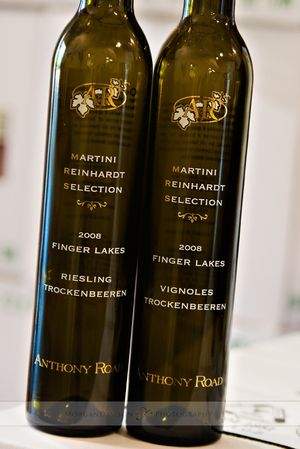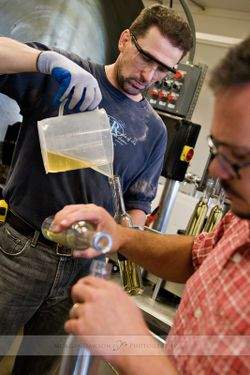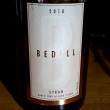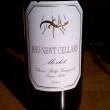The Wine of His Life: Anthony Road Set to Release Riesling TBA
By Evan Dawson, Finger Lakes Editor
Photos by Morgan Dawson Photography
If you're the type of wine drinker who tunes out when people start talking about "dessert wine," I'm going to ask you to abandon your prejudice. This is the story of a wine that is way beyond a simple after-dinner drink. With apologies to the many nicely made ice and dessert wines in New York state, the TBA is so much more than that. And in this case, it's a wine that a German-born winemaker Johannes Reinhardt dreamt about for years, wondering if he'd even get the chance to attempt it. The conditions had to be perfect. The staff had to be prepared for an intense 48 hours. Their feet would do the work traditionally done by the crusher.
All of those factors came to pass one year ago, and last week the wine finally found its bottle.
TBA is short for "trockenbeerenauslese," which is the German classification for this riesling royalty. It translates to "dry berry select." Bureaucrats, in their endless quest to inflict death by regulation, don't allow American wine to carry that name. Thus, Anthony Road Wine Company on Seneca Lake is calling their wine "Riesling Trockenbeeren," but in conversation it's often referred to as "TBA."
Having worked on the sorting line for this wine, I'll take you back to the rather hilarious moment when the winemaker bounded into the winery to make an announcement. It's worth knowing the story if you're going to pay triple-digits for this wine.
2008 conditions were ideal for TBA
"I almost can't believe this," Johannes said, nearly tripping in his knee-high rubber boots. "The first reading is 43 brix. That's the highest I've seen. And okay, to be honest, it's almost too much!"
In non-winemaker speak, 43 brix is a hell of a lot of sugar in a grape. TBA is made from botrytized grapes — grapes that have been infected by botrytis, otherwise known as "noble rot." This is not like putting lipstick on a pig; botrytis can actually be a wonderful thing under the right circumstances. The summer rains set up a harvest that was rife with noble rot in some places, and Johannes decided that this was his chance to make a true riesling TBA. In his decade of making wine in the United States, he had never attempted it.
"For me it's not something you can force every year," he said that fall day. "I may not see this chance again. But if we're careful, we can make something special."
Working on the sorting line was a high-pressure endeavor. There were several dozen of us working with bins filled with picked riesling grapes. Our job was, first and foremost, to make sure no sour grapes got into the batch. Some of the grapes were kind of vinegarized — they smelled extremely sour and betrayed more of an orange color. "Even one or two sour berries can change the quality of the batch," Johannes warned. "We simply must be precise." And so we were, happy riesling soldiers picking out sour berries, and tossing out the rock-hard ones. The cheerful mariachi music put a bounce in the step of my Mexican friends on the line.
The final brix reading for the riesling clocked in at 39. Within 48 hours the grapes were off the vine and crushed by foot. Given the vigilance on that sorting line, I doubt a single sour berry made the cut.
More than just riesling TBA
Johannes decided to also make a vignoles TBA, as well as a riesling BA and a pinot gris bA. The latter two are wines that checked in with slightly lower brix and will carry a moderately lower price tag. (BA stands for "beerenauslese," which is just a notch down from TBA in the German hierarchy.)
The pinot gris BA will retail for $35 per 375 ml bottle. The riesling BA will run $65 per bottle, while the vignoles TBA will carry a price tag of $75 and the riesling TBA checks in at an even $100.
"The price does not only reflect the quality of the wines," explains assistant winemaker Peter Becraft. "It's reflective of the huge amount of labor that is required to make these wines the right way. We didn't cut corners on a single part of this effort, and we think it shows up in the wine."
The riesling TBA tastes like a dried apricot dream, with so many supporting flavors that I won't bore you with the list. It's more fun to let them unfold on your own. The vignoles is quite a different TBA, owing completely to the much higher acidity that is naturally present in the grape. Consequently it's crisper but with a little less length.
Anthony Road will release the riesling BA and pinot gris BA this month, followed by the riesling TBA in January and the vignoles TBA in March.
So why doesn't everyone make a TBA in the Finger Lakes?
The simple reason is that you have to be really, really good at what you're doing. And it's pretty darn risky for winemakers who don't have experience to give this a shot. A few too many sour berries, or too long between picking and crushing, or even recognizing when to pick — it all factors into the best TBAs.
As far as we know, there are two other wineries that produce a TBA in the Finger Lakes: Hermann J. Wiemer and Dr. Frank. The Wiemer is sublime and retails for a little less than the Anthony Road Riesling TBA. Sometime soon I hope to try the Dr. Frank version.
On bottling day at Anthony Road, Johannes conceded how thrilled he was with this wine. "If I'm being honest I'll say that I'm 95 percent with this one," he said with a smile. Peter Becraft later told me, "If Johannes is happy, that's really saying a lot. He can be very hard on himself. But it's hard not to love what's in this bottle."



















I had a chance to try the Dr. Frank’s-it was amazing.
There are a handful of wineries making some unique products such as these and I’m excited about them. I wish they were slightly cheaper but I understand it’s a lot of labor and in limited supply.
Trivia: back when Scott Harvey made a Sonoma TBA Riesling for Santino in the 80′s, he had to convince the authorities that “TBA” stood for “Totally Botrytis Affected” before they’d give the label a pass. Times have clearly changed..
Joel - Great story! You’ll note, of course, that TBA doesn’t appear on the label in this case; it’s just used colloquially. But I suppose even getting the term “trockenbeeren” is a step forward…
Jason - Translation: “I wish I had more money to spend on wine.” Me too, man, me too…
Seriously, the subject of price has been a hot topic on this blog for months. In plenty of cases I think prices are too high. In this case, having seen the massive amount of labor and resources to produce a relatively small amount of wine, I understand the reasoning.
I wouldn’t necessarily say “I wish I had more money to spend on wine” versus “I hope wines are always priced in a way that is reasonable and obtainable.”
I think the subtle difference is that the latter statement reflects my desire to spend just enough money to obtain the quality range I seek. I don’t want to overspend for mediocre or even good wines. Excellent wines should be priced in a way that allows for a careful choice, not an outright sacrifice.
I do believe that the market will usually bear this out, however. I’ve seen some anecdotes about French and California prices coming down precipitously, and I don’t think it’s just the economy so much as prices skyrocketed over the past few years.
In the case of these wines, maybe they’re at the right price point and maybe they’re not, but I do agree that they should be priced to reflect their craftmanship.
It will be very interesting to see how these wines sell at those prices — in the Finger Lakes.
I occasionally hear, when Finger Lakes folks talk about Long Island wine prices “People up here just won’t pay those prices people pay down there.”
Now I guess we’ll see, as Jason says, what the market will bear.
Two things to keep in mind here…
First, similar style/quality wines from Germany actually cost much more than $100 per bottle (talking about the riesling TBA here).
Second, when the CFO of LENNDEVOURS Enterprises (that’d be Nena) tasted these wines over the winter, she said we’re buying some upon release.
Evan, The Pinot Gris BA will be our Anniversary Wine to celebrate the 20 year anniversary of the opening of the ARWC tasting room, With this in mind we will most likely release that wine in 2010.
Peter - I blame your head winemaker for getting it wrong!
Being someone who has helped sort grape by grape for a TBA Riesling in 2008, I can tell you that the contents in those bottles are priceless.
Botrytis sort of pokes holes in the grape skin and dries out the berries. The tight clusters of riesling and vignoles contribute to Botrytis infection, and the right amount of moisture is essential. Too much botrytis and your grapes are gone, but with just the right conditions, you’ve got something magical. Kudos to Johannes for recognizing this potential.
The sour, “vinegarized” grapes are likely infected with acetic acid bacteria, something that would just LOVE to get in and multiply in a slow fermentation (39 Brix puts an awful lot of osmotic stress on yeast). I’m sure JR is right when he says that one sour berry could spoil the batch.
I tasted some of this wine from the tank (they were pouring it for FREE?!?!?!) and it was remarkable. If you can’t part with a Benjamin, the “Berry Selection” was really great, too.
I think the subtle difference is that the latter statement reflects my desire to spend just enough money to obtain the quality range I seek. I don’t want to overspend for mediocre or even good wines. Excellent wines should be priced in a way that allows for a careful choice, not an outright sacrifice.